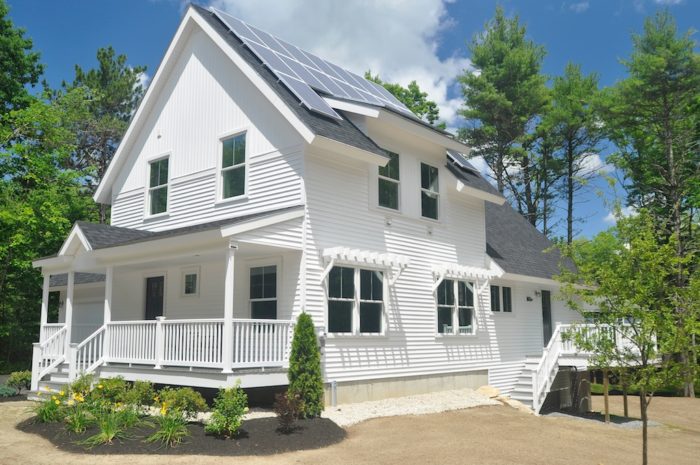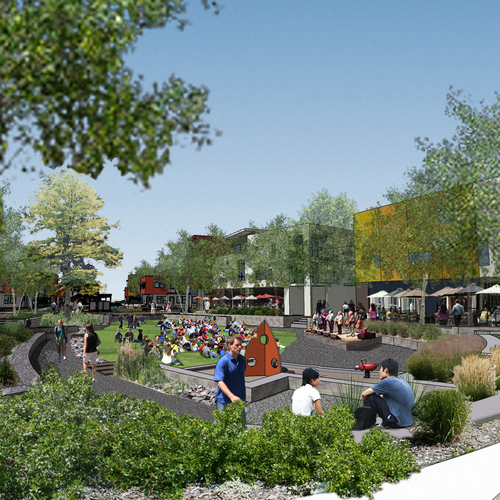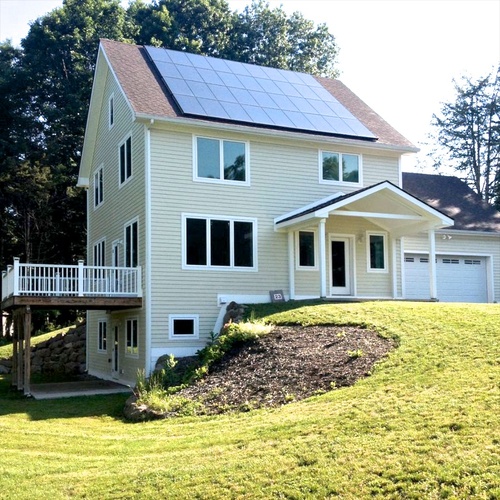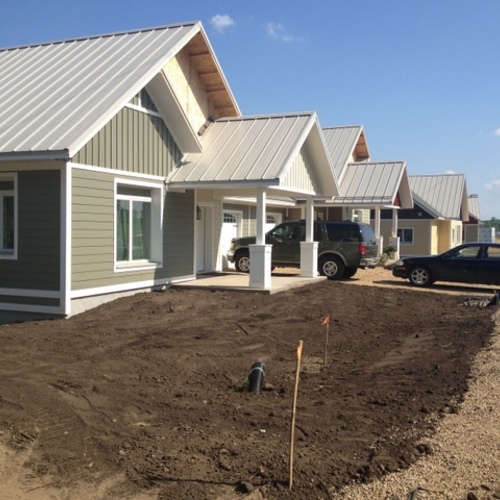Net-Zero Subdivision
A model house in Wells, Maine, is part of a planned subdivision that will have 26 homes when fully built out. All of them will be net-zero ready.Image Credit: Scott Gibson
Net-Zero Subdivision
A model house in Wells, Maine, is part of a planned subdivision that will have 26 homes when fully built out. All of them will be net-zero ready.Image Credit: Scott Gibson
Simple floor plan
The two-story, 1750-sq. ft. model house features a mostly open first floor plan, 12-in. thick walls and triple-pane windows.Image Credit: Scott Gibson
Camouflaging thick walls
First-floor windows have splayed window openings, disguising the 12-in. thickness of the walls and increasing available light.Image Credit: Scott Gibson
Timing was right
Builder Jesse Ware, one-half of the Futuro team behind the subdivision, in the kitchen of the first home to be built.Image Credit: Scott Gibson
Two southern Maine builders have teamed up with Kaplan Thompson Architects on a subdivision that will include as many as 26 houses built to net-zero standards.
The first of the houses in a Wells, Maine, subdivision called Brackett Estates, is a 1750-sq. ft., three-bedroom model called the Appledore, which was completed in mid-June. The two-story, all-electric house includes double-stud walls insulated to R-40, triple-glazed windows, and a roof insulated to R-60 with dense-pack cellulose. It’s on the market for $429,000, or just under $250 a sq. ft.
Among its other energy features:
- Mitsubishi ductless mini-splits for heating and cooling.
- A heat pump water heater for domestic hot water.
- Passive whole-house ventilation with wall-mounted air inlets and timed bathroom fans.
- A 4.3 kilowatt, grid-tied photovoltaic array mounted on the roof.
The subdivision is the work of Futuro, a partnership of builders Jesse Ware and Craig Briggs, and Kaplan Thompson Architects of Portland, Maine.
Architecturally, the house has a contemporary New England flavor, with an exterior finished in white (vinyl) clapboards, a porch protecting the front entry, and an attached, two-car garage. Inside, the house is clean and bright with amenities that Futuro hopes will interest savvy buyers: strip maple floors, granite countertops, high-end kitchen appliances and an attached deck at the rear of the house.
But the emphasis is clearly on performance. Ware says the design follows the 60-40-20-10 insulation standard, meaning the roof is insulated to R-60, walls to R-40, basement walls to R-20 and insulation beneath the slab at R-10.
Because insulation was still to be sprayed on the inside of basement walls in early July, blower-door test results were not available. Architect Phil Kaplan said the house was designed with Passive House energy modeling software, and that he hoped it would test at between 1.5 and 2.0 ACH50 (the Passive House standard is 0.6 ACH50).
Modular construction with net-zero capability
The house was built by Keiser Industries in Oxford, Maine, and delivered to the site in 48-ft. long modules. Keiser is the same modular builder that Kaplan Thompson had worked with previously on a pilot project to deliver two net-zero modular homes to Peaks Island in Casco Bay, just off Portland. That project has been on hold.
Ware says that the idea is to deliver a building envelope capable of net-zero energy performance even if homeowners choose not to add renewable energy systems as soon as they move in. Houses will have conduits running from the basement to the attic allowing easy installation of PV panels at a later date.
At the model house, the PV panels added about $12,000 to the price tag after federal rebates. The 4.3-kW capacity, Ware says, is a little short of being able to deliver net-zero performance. To get all the way there, homeowners would have to add slightly more PV capacity.
Futuro took what steps it could to keep the house affordable. The siding, for example, is vinyl, and kitchen cabinetry while better than basic, is, in Ware’s words, “not over the top.” Bathrooms are relatively modest in size with tile floors but plastic, not tile, shower surrounds. Another cost-cutting move, Ware says, was not to seek LEED certification, which would have added some $5,000 to the cost.
In all, there are four house models, ranging in size up to 2400 sq. ft. Futuro hopes to build seven houses this year, but if demand over the next 30 to 60 days is strong, the partnership may extend the road into the subdivision to speed up construction.
Betting on strong demand
Despite efforts to keep costs down, the houses are not inexpensive, and local real estate agents quoted in an article about the project in the Portland Press Herald weren’t convinced the houses would have broad market appeal.
But Ware is betting buyers will be willing to invest in a house where there are no energy costs.
“We’re betting they will,” he says. Using energy modeling, architects determined the house would be 67% more efficient than a house with the same floor plan built to current energy code standards, Ware says.
And even with significantly more insulation and triple-glazed windows, Kaplan says the house is no more expensive to build than one of comparable size without the energy features, mainly because it doesn’t need a conventional heating system.
“I got real serious about this two years ago,” Ware says, “and starting looking around for a place to do it. My initial inspiration was to go to NESEA and see some of the homes that were done down on the Cape in Massachusetts, and we said, ‘Gee, we need to bring those to Maine.’ I think this will work.”
This also seemed like the right time to try a net-zero community in the area. Wells is within easy driving distance of the greater Portland area, as well as both New Hampshire and Massachusetts.
“Real estate sales were starting to uptick in this area,” he says. “That was one thing that made us feel more comfortable about doing this, and I think it was just a gut feeling that the time was right to get this kind of construction out to the mainstream public. And that’s our goal here, to try to bring a green, self-sustainable product to a middle-range buyer, to make this attainable as possible.
“So often you say, ‘green’ or ‘net-zero’ and people go, ‘Oh my God, I’ve got to spend a million bucks.’ It doesn’t have to be, and we’re proving that here. It doesn’t have to be a million dollar house. We’re in the high threes, starting, and that’s a pretty good value, I think.”
Weekly Newsletter
Get building science and energy efficiency advice, plus special offers, in your inbox.
















17 Comments
Love this.
I think Kaplan Thomspon are doing great things and joining forces with other firms and industries to find economies to make things more attainable is icing on the cake.
As much as it might go against some principles of sustainability, I'd personally like to see more options for larger families that might need some extra space or flexibility. For instance, I have yet to see much work on a home for a family of 5 (3 kids) who might have older members of the family visiting or staying, so a 4-5 bedroom, with a thoughtful layout that can be build for less than say $350k considering you have to purchase a site to put it on too. I think a variation of the home above might hit that target.
It's beautiful.
Really great. It's a sensible size, beautifully proportioned, and it actually looks like an American house. Many congratulations to the builder. Minor Quibbles: Guilty of Vinylside in the first degree. (But what can you do? It's not like we have an oversupply of clear cedar.) And, well, I don't know about you East Coasters, but here in the West there's so much granite going into countertops that the sheer weight of it is threatening to crack our shoreline and send us sliding into the sea. The Formica in my kitchen, still in great condition, has been there since 1952. And I've never yet broken a glass by setting it down. Still, this is an admirable house.
To brian m, et al.
Thanks for the comments. Big kudos to Keiser Homes - our Modular buddies - and Futuro, a smart and motivated crew. We have actually developed a total of 7 homes for sale as modulars, including both an even smaller ranch and a larger home as brian m suggests. Stay tuned for a new website showcasing the entire Modular Zero line. We are always looking for builders in other regions, both modular and otherwise, to team up with.
And regarding vinyl, we don't love it but affordability is first and people can upgrade as they are able. I think one of the keys to success with this line is to go all white. It feels clean and bright, and avoids all the nasty muted colors which seem to be the only ones available in vinyl.
Still one of the things we question internally is using the tag of "net zero" when we know it's really up to the users, not us. Our energy models show we'll still need around 6.5kW of PV if we use Solar DHW.
Where is the HPWH?
Phil, the heat going into the hot water ultimately comes from outside the house, with a higher total temperature rise than for just heating the house in winter. While the overall COP of that rise will be somewhat less than for just the minisplit by itself, the energy cost for hot water will be less than by straight resistance heating, so that aspect of a HPWH is good. Still, I would think that a big downside to use of one in Maine would be the chilling of the area immediately around the unit, with localized thermal discomfort in winter. Where is the unit located, and what was your reasoning in selecting a HPWH for a Maine location?
Where is the HPWH?
Dick, it's located in Wells, Maine, much closer to Portsmouth than Portland, and sits in the basement. We'd looked into it on another project and the COP of 2 for DHW was appealing, but we couldn't get past the higher price tag. Originally a Marathon was specified here, and the decision to go for it came from the builder's end. It does lower the number of panels we'll need to get to net zero, but we need to weigh that against the added cost of the unit and, as you say, the localized chill. The builder, Jesse Ware of Futuro, is looking into specifics and hopefully can weigh in in the next couple days.
You're right about the color.
White is quite appropriate for New England, and to me it felt like a refreshing change.
Thick walls
Love the splayed window reveals, the light effects are wonderful, but sorry you feel the thick walls have to be 'camouflaged'. As well as providing excellent insulation values thick walls enhance a home's feeling of security, protection and enclosure. Revel in them, use them as a selling point.
Blower Door results in
As I had hoped, the ACH50 came in at 1.77 with the basement excluded since it has yet to be fully sealed. Once that does happen, we're extrapolating to an ACH50 of 1.45. Based on John Straube's comments on his Waterloo Multi-family project, he feels that trickle vents are a fine, affordable option in lieu of ERVs as long as the ACH50 doesn't get below 1.5. Looks like the builders did as well as could have been hoped.
I'd like to hear others' experiences with passive air inlets on tight homes. We know there's risk involved, especially when not being able to do a mid-construction blower door test.
Regarding the HPWH, Builder Jesse Ware reports that it cost about $1500 more than a Marathon, not including installation costs for the condensate line.
I am a huge fan of net zero.
I am a huge fan of net zero. Great great great. Keep forging ahead all.
I failed to mention I think HPHW heaters are for cooling climates, not Maine or the Adirondacks unless paired with excess wood heat source.
I bet if we could read the
I bet if we could read the emails between the engineers and the marketing people at GE as to HPHW heaters being suited and or advertised to make economic sense in a cold climate, we all would learn the real truth as to when and where HPHW should be installed.
$1500, big nut to crack.
This is the solution
Hi Phil,
I am in Warren Vermont and am in the process specifying and building a virtually identical home. 60/40/20/10, a little bigger at 2300 sq, but the same idea, no fossil fuels, all electric, ASHPs. for heat and water...Getting the house built isn't my problem, it is finding a HVAC contractor that can model and spec the system I need. Got any recommendations?
Mike
Passive Air Inlets in Tight Houses
Phil,
I'm surprised John Straube said passive air inlets / trickle vents are fine, as long as the ACH50 doesn't get below 1.5. I would think it would be the other way around.
Response to "This is the solution"
Mike,
A bit of shameless self promotion here that might help you. Our firm happens to offer modeling, HVAC system sizing, system spec, and distribution design. We specialize in high performance, work across New England, and can act as a third party - but we don't install. Your installer would receive all they need to match your high performance building envelope (which they may not see very often...)
Adam
http://www.zeroenergy.com/serviceoverview.html
Trickle vent question
John, you are correct. Just found the presentation online:
http://www.buildingscienceconsulting.com/presentations/documents/2010-03-09-dorset_case_study.pdf
Glad we just made it then (smile).
Thanks, Phil
I was worried I was barking up the wrong tree!
Editorial Correction
I just wanted to clarify that the article states we are considering stick building as an alternate to the modular. We are committed to using the modular construction with Keiser Homes. Stick building is an available option for new home-buyers at Brackett Estates. With the recent blower door results, the overall construction quality and the speed at which we can turn around a new home with Keiser we are sold on the Modular Zero product.
Response to Jesse Ware
Jesse,
Thanks for your comment; I have corrected the text of the article.
Log in or create an account to post a comment.
Sign up Log in